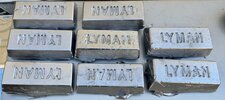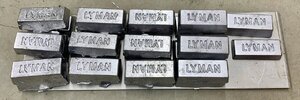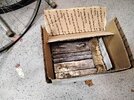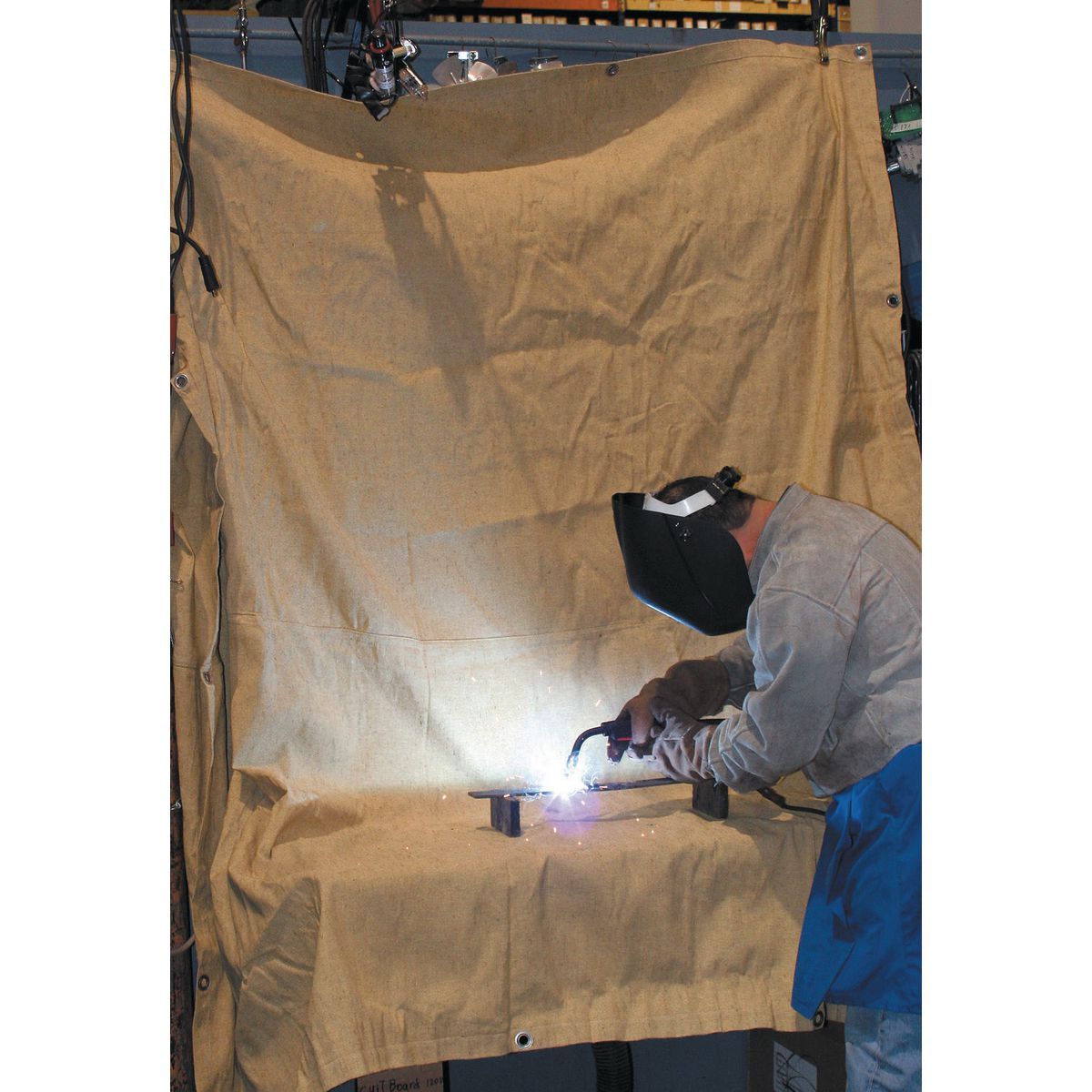JimGnitecki
Member
- Joined
- Mar 28, 2010
- Messages
- 1,258
In other threads, I have mentioned that I was given maybe 80 to 100 lb of really old wheelweights (hereafter referred to as "WWs" to save typing) - the supposedly "good" ones from over 30 years ago, before WW makers started using a lot of Zinc which makes modern WWs pretty much unusable. But, today I discovered some of the realities of using even these "good" WWts.
I had previously washed ALL the WWs I was given using a water with Dawn dish soap solution. With the solution and the WWs inside a heavy duty thick industrial plastic bin, I sloshed the solution over the WWs back and forth by tipping the bin from side to side, prpducing a washing action similar to how a home clothes washer agitates clothes to clean them.
Then, I rinsed them very thoroughly with a pressure nozzle on our outside garden hose.
Then, I let them dry several days in the garage to eliminate ANY trace of water which could disrupt my melting session by allowing the appearance of the Tinsel Fairy!
Yesterday and today, I have so far done 2 melting and purification sessions, where I melted the WWs, extracted the clips from the melted WW alloy, and then fluxed until I had what looked like pretty pure alloy without any appreciable remaining impurities.
The first reality I learned in doing so, was that yes, a cold mold does cause wrinkling of any Lead alloy poured into it, verifying why we get wrinkled bullets at the start of our bullet casting sessions. In the photo below, the ingots that show wrinkles were the ones cast when the ingot mold was cold. The ingots that do NOT have wrinkles were poured in 2nd or 3rd pours into molds already preheated via prior pours into them minutes beforehand:

The next reality is that the GROSS weight of any pile of WWs is NOT an accurate predictor of the NET usable WW alloy you will end up with!
Between yesterday's and today's 2 melting and purification sessions so far, I ended up with this stack of WW ingots:

That's 26 ingots of varying weights. It LOOKS impressive, but it is only a net weight of 21.9 lb of Lead alloy.
That's because those 2 melting sessions ALSO produced these 3 stacks of WW clips, dross, zinc WWs, and some Lead alloy that had to be skimmed off the molten Lead in order to get ALL or at least most of the impurities and have only a clean Lead layer on top of what was in the pot:

Those aluminum "plates" the clips/dross/lost Lead are sitting on are each 6" x 6" aluminum TIG welding "coupons" I used up in TIG welding practice. The piles of Clips/Dross/zinc pieces/lost Lead"debris" on each of the coupon plates were about 3" high!
I weighed the debris (withOUT the plates), and it totaled to 8.1 lb !
So, here's the math:
Start with 21.9 + 8.1 = 30 lb of WWs. (I'm ignoring the insignificant actual weight of the burnt sawdust flxuing agent you see remaining in the 3 piles).
End up with a NET weight of 21.9 lb of Lead alloy (all hopefully good, with no Zinc hidden in any of it).
So the net weight of usable Lead alloy from a gross of 30 lb of WWs is only 21.9 / 30 = 73%.
And this is with the GOOD (over 30 years old) WWs. Any NEW WWs, where the precnetage of pure Lead is lower, are going to presumably be worse. And remember too, I had already removed all non-metallic debris, like dirt, tire valves, WW double sided tape, etc.
So, if you are actually PAYING a tire shop for its used WWs, keep in mind that you are getting only 73%, or LESS, of the weight you are paying for in actual Lead.
Jim G
I had previously washed ALL the WWs I was given using a water with Dawn dish soap solution. With the solution and the WWs inside a heavy duty thick industrial plastic bin, I sloshed the solution over the WWs back and forth by tipping the bin from side to side, prpducing a washing action similar to how a home clothes washer agitates clothes to clean them.
Then, I rinsed them very thoroughly with a pressure nozzle on our outside garden hose.
Then, I let them dry several days in the garage to eliminate ANY trace of water which could disrupt my melting session by allowing the appearance of the Tinsel Fairy!
Yesterday and today, I have so far done 2 melting and purification sessions, where I melted the WWs, extracted the clips from the melted WW alloy, and then fluxed until I had what looked like pretty pure alloy without any appreciable remaining impurities.
The first reality I learned in doing so, was that yes, a cold mold does cause wrinkling of any Lead alloy poured into it, verifying why we get wrinkled bullets at the start of our bullet casting sessions. In the photo below, the ingots that show wrinkles were the ones cast when the ingot mold was cold. The ingots that do NOT have wrinkles were poured in 2nd or 3rd pours into molds already preheated via prior pours into them minutes beforehand:

The next reality is that the GROSS weight of any pile of WWs is NOT an accurate predictor of the NET usable WW alloy you will end up with!
Between yesterday's and today's 2 melting and purification sessions so far, I ended up with this stack of WW ingots:

That's 26 ingots of varying weights. It LOOKS impressive, but it is only a net weight of 21.9 lb of Lead alloy.
That's because those 2 melting sessions ALSO produced these 3 stacks of WW clips, dross, zinc WWs, and some Lead alloy that had to be skimmed off the molten Lead in order to get ALL or at least most of the impurities and have only a clean Lead layer on top of what was in the pot:

Those aluminum "plates" the clips/dross/lost Lead are sitting on are each 6" x 6" aluminum TIG welding "coupons" I used up in TIG welding practice. The piles of Clips/Dross/zinc pieces/lost Lead"debris" on each of the coupon plates were about 3" high!
I weighed the debris (withOUT the plates), and it totaled to 8.1 lb !
So, here's the math:
Start with 21.9 + 8.1 = 30 lb of WWs. (I'm ignoring the insignificant actual weight of the burnt sawdust flxuing agent you see remaining in the 3 piles).
End up with a NET weight of 21.9 lb of Lead alloy (all hopefully good, with no Zinc hidden in any of it).
So the net weight of usable Lead alloy from a gross of 30 lb of WWs is only 21.9 / 30 = 73%.
And this is with the GOOD (over 30 years old) WWs. Any NEW WWs, where the precnetage of pure Lead is lower, are going to presumably be worse. And remember too, I had already removed all non-metallic debris, like dirt, tire valves, WW double sided tape, etc.
So, if you are actually PAYING a tire shop for its used WWs, keep in mind that you are getting only 73%, or LESS, of the weight you are paying for in actual Lead.
Jim G



